Compliance Minute – Simplify your EHS Compliance Tasks with Groups
When looking for a GHG reporting program, there is one element that is typically overlooked. This short video gives us more insight.
When looking for a GHG reporting program, there is one element that is typically overlooked. This short video gives us more insight.
When looking for a GHG reporting program, there is one element that is typically overlooked. This short video gives us more insight.
[sc_vimeo width=”640″ height=”360″ aspect_ratio=”16:9″ video_id=”834111151″ style=”default” position=”right”]
When looking for a GHG reporting program, there is one element that is typically overlooked. In a short video Locus Technologies President, Wes Hawthorne, gives us insight into what that missing piece is. If your company needs better GHG reporting solutions, Locus Technologies has the expertise and software to complete your reporting efficiently and accurately.
Click to learn more.
[sc_button link=”https://www.locustec.com/applications/sustainability/greenhouse-gas/” text=”Learn more” link_target=”_self” color=”000000″ background_color=”52a6ea”]
As if the world of calculating forest and natural assets to be used as carbon offsets for big businesses isn’t complicated enough, now there’s a huge new, unexpected issue. Wildfires are threatening the underlying nature itself.

A pyrocumulus cloud from Oregon’s Bootleg Fire can be seen for miles as it burns in the Freemont-Winema National Forest. As of Thursday night, the fire had burned more than 400,000 acres, including forest that had been preserved to compensate for greenhouse gas emissions elsewhere. Photo: National Interagency Fire Center.
The wildfires in the American West this past summer, including one big fire in Southern Oregon, the Bootleg Fire, torched a large percentage of land set aside for carbon offsets. Another fire in Washington State threatened an Indian reservation carbon offset project. Companies who produce greenhouse gases pay nature and forest reserves to maintain and build themselves out to help trees pull carbon from the atmosphere. The offset allows the companies to claim they are carbon neutral. The more they pollute the more they pay. A growing financial market for offsets in Europe, the UK and now China is based on the premise these assets can be correctly measured and managed.
That premise routinely comes under fire, as one forest is different from another, some trees in the same forest suck carbon at a different rate then others and, of course, there’s no way to tell how a forest used as an offset today will look 100 years from now. Now the natural land is coming under fire literally. In order to counteract CO₂’s climate-warming properties, a carbon offset project needs to promise to sequester carbon permanently. That’s because CO₂ can linger in the atmosphere for up to 1,000 years. If the carbon that is avoided or removed ends up getting released, then the program is flawed. The impact of the fires is already generating calls from advocates who argue carbon output needs to be reduced at its source, not offset with money and accounting gimmicks. Those are legitimate arguments but as we are nowhere near approaching a global scenario like that, offsets are our best shot to make polluting more expensive and ultimately reduce it.
The problem is that the offset market is developing so fast that all the parties in it — buyers, sellers, brokers — are profiting, and so are thinking of new ways to grow it. Already, ideas about securitization of carbon offset assets, where they would be packaged into tradable derivatives, like mortgages or interest rate products, are catching on.
This feeds into more participants in the carbon market, and as a result, higher prices, and then more participants on that. On the European Trading System for carbon prices, the value of futures contracts for UK carbon topped $100 (£ 72.4 pounds) in late September amid the country’s petrol delivery crisis. But none of this compares to what could happen if global leaders can advance the idea of an international carbon price and emissions trading mechanism at the United Nations’ COP26 global climate summit in Glasgow in November.
The carbon market, one way or another, is certain to develop in coming years, and with it, the potential for abuses. Those can be fought by new regulations and better policing of markets. But at present, there is nothing to stop the natural threat of fires or other disasters on the underlying offset assets. In the investing world, we call these developments Black Swans. Something completely unexpected that comes along and upends markets. Kind of like China’s sudden attack on its tech industry this past summer, and its impact on Chinese stocks worldwide. It is another sad and ironic tragedy of climate change that global warming itself is destroying the very tools we have to fight it.
[sc_image width=”150″ height=”150″ src=”24014″ style=”11″ position=”centered” disable_lightbox=”1″ alt=”David Callaway, Callaway Climate Insights”]
About the Author—David Callaway, Callaway Climate Insights
David Callaway is founder and Editor-in-Chief of Callaway Climate Insights. He is former president of the World Editors Forum and editor of USA Today.
[sc_button link=”https://www.locustec.com/applications/sustainability/greenhouse-gas/” text=”More on GHG” link_target=”_self” centered=”1″]
Integration with other systems, whether on-premises or in the cloud, has become a key wishlist item for many EHS software buyers. It allows you to take advantage of other tools used by your organization (or available from third parties) to simplify processes, access information, and enhance communication, both internally and externally.
This blog will take a look at some common types of integrations we most hear about when talking with EHS professionals.
Many potential software buyers want to integrate an existing on-premises system with a Software as a Service (SaaS) system. The SaaS integration advantage is accessing information in existing systems without the additional user burden of using multiple software systems, making it easier to perform parts of a unified business process.
A good example is creating a cloud system that integrates with an onsite Enterprise Resource Planning (ERP) system such as SAP. Many business processes must connect external vendors with internal resources to track work, scope, invoices, and payment. Cloud systems are ideal when external vendors need internal interactions.
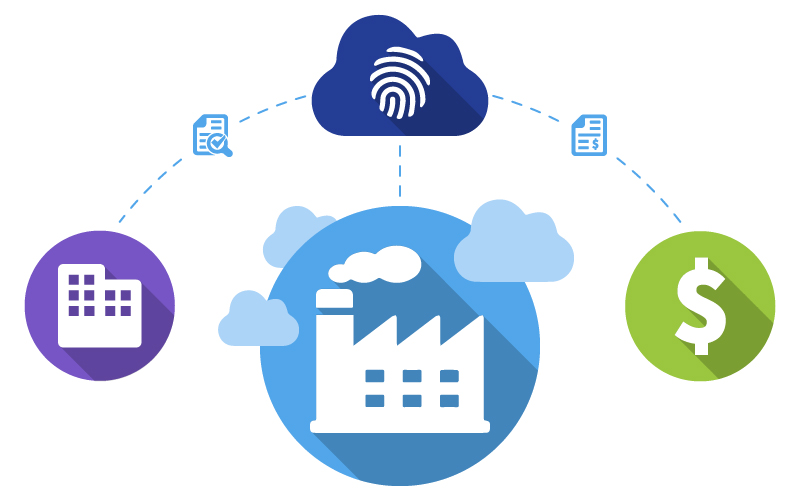
In this example, previously, vendors sent invoices as email attachments, then had to be manually entered into the owner’s ERP system. The vendors had zero visibility into the processing status of the invoice, thus slowing down the flow of information between the owner and vendors. The owner wanted to create a single view of the contracts, vendors, the approved budgets, and the payment approval status to streamline the process and enhance transparency.
To meet the customer’s enhancement request of a “Single View” data had to be integrated securely between the on-premises secure ERP system and the cloud system. First, the owner established a secure web service API. The cloud system authenticates and consumes the API over an encrypted connection to integrate the process. Maintaining security for all parties, and application users have full access to the specific data they needed to complete their business flow.
One caveat to this type of solution is that the owner’s IT personnel are often involved in establishing a pathway to the internal data and gaining internal approvals for this to happen. Therefore, if you are considering integration with internal systems, check with your internal resources to make sure they can accomplish your goals while adhering to your corporate IT security policies.
Many companies request single sign-on (SSO) for their users when accessing a third-party cloud software. This functionality can be a key purchase criterion for selecting a software vendor. SSO integration termed “integration with identity providers,” is especially important for large enterprises and many geographically distributed users.
Using SSO, company employees authenticate in their own employee portal. When an employee clicks on a link to the software provider, they are taken to the provider’s website and presented with the correct information based on her authorization, without having to log in again.
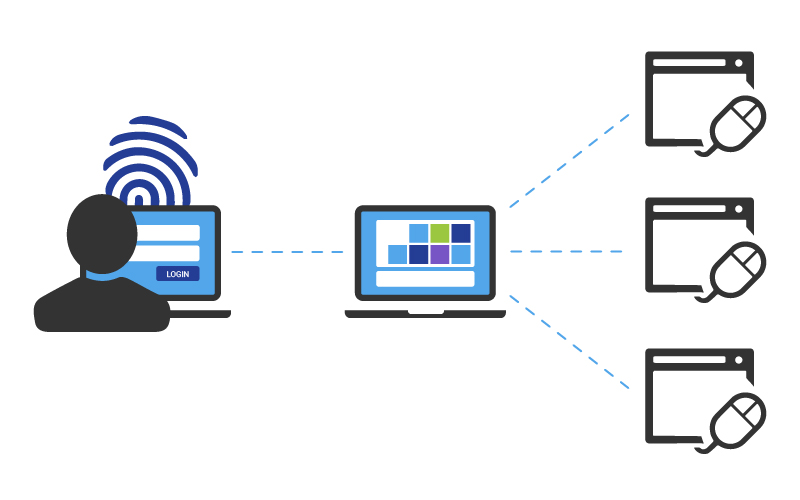
One approach to providing this functionality is to use Security Assertion Markup Language (SAML) assertion through integration with the company’s identity provider (IdP). In a typical use case, the vendor software maintains the user identities and permissions for every employee at the company needing access to the EHS software. When an employee of the company accesses the vendor’s SaaS applications, the SaaS sends an authentication request to the company’s IdP at this point he IdP authenticates the user and sends a SAML response. Allowing the user access the relevant parts of the vendor’s SaaS software.
The user experience is a seamless workflow and one less set of credentials to manage. It also provides a method to simply and quickly remove users when they leave the company or no longer need access to the software. Once removed from the company authorization, access to the external software is also removed.
Government agencies and other public/private entities are increasingly delivering services or requiring data submissions via publicly available APIs (Application Programming Interfaces). API’s help both parties by significantly streamlining data submission (such as submitting hazardous waste manifests to EPA). More importantly, electronic data submissions all but eliminate the tedium and the likelihood of errors in manual and repetitive data entry. However, the benefits of API data exchange impact users only if their software is capable of making the connection and sending the information safely and accurately to the intended recipient.
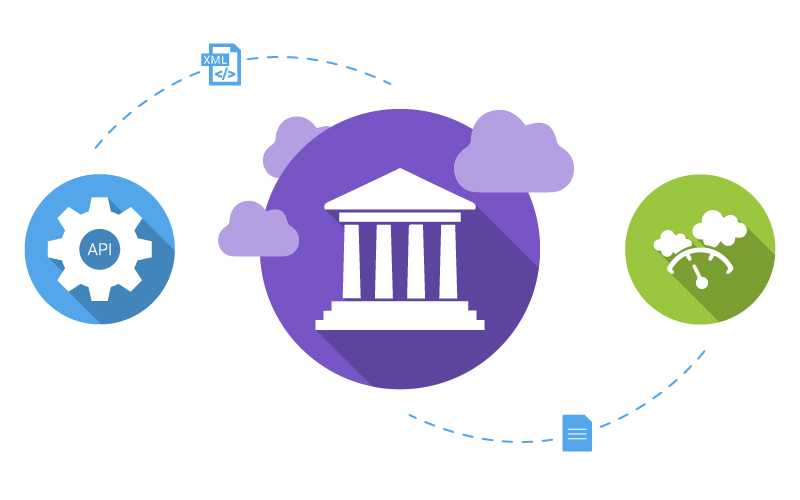
EPA’s public REST API for submitting GHG emissions reports
One example where APIs are extremely useful is in the submitting annual GHG (greenhouse gas) emissions to EPA. Previously, GHG regulatory report submission was a manual process on the EPA website. Data was typically calculated in spreadsheets for multiple sites and manually entered into the EPA website. This manual process was both slow and error prone.
To streamline the regulatory reporting process, EPA introduced an option to upload files that are formatted per EPA specifications. The specification allows combined data from each reporting site (for multi-site facilities) to be submitted as a single consolidated XML file.
The software can provide reporting tools that make it easy to run multiple reports and combine results in a single XML, which is designed to be suitable for submission to EPA. In the future, when EPA provides an API, the process will become even more streamlined for data owners, and the upload portion of the process can be eliminated.
EPAs e-Manifest system has recently gone live and is another great example of integration with a public API. Automating submission of hazardous waste manifests will be a huge time saver for all entities that are required to ship waste. The new system will also finally put to rest the clunky dot matrix printers that are kept around only to print out these manifests. For this type of integration, look for built-in tools to configure automatic submission of manifests with EPA’s public REST API web service. Because this is new (July 2018), expect some trial and error on the first submissions, but after the integration is worked out, it will be a game-changer for companies required to ship and transport waste.
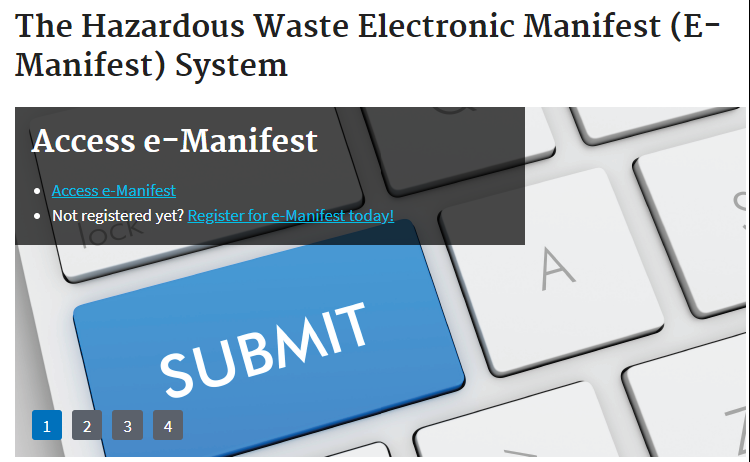
GIS integrations for visualizing site and facility data
Mapping and geographic information systems are another popular public API integration option for EHS software. Using Esri (a leading geographic information system) public APIs, EHS software can validate location data for address formatting and accuracy across a range of applications. This type of integration is typically easy to configure and you just need to create the business rules that integrate with Esri APIs to check, format, and store the correct address and geo-coordinates for locations.
Google Maps APIs can be used to show relevant maps of sites or facilities and overlay useful information like terrain, demographics, or traffic to make the EHS data more meaningful and understandable. Similarly, devices with GPS tracking can be visualized in dashboards to see current sampling locations or inspection locations in a map view. These types of integrations are very familiar to most software users and are easy to configure as most sources of information are readily available publicly and come with well documented API information.
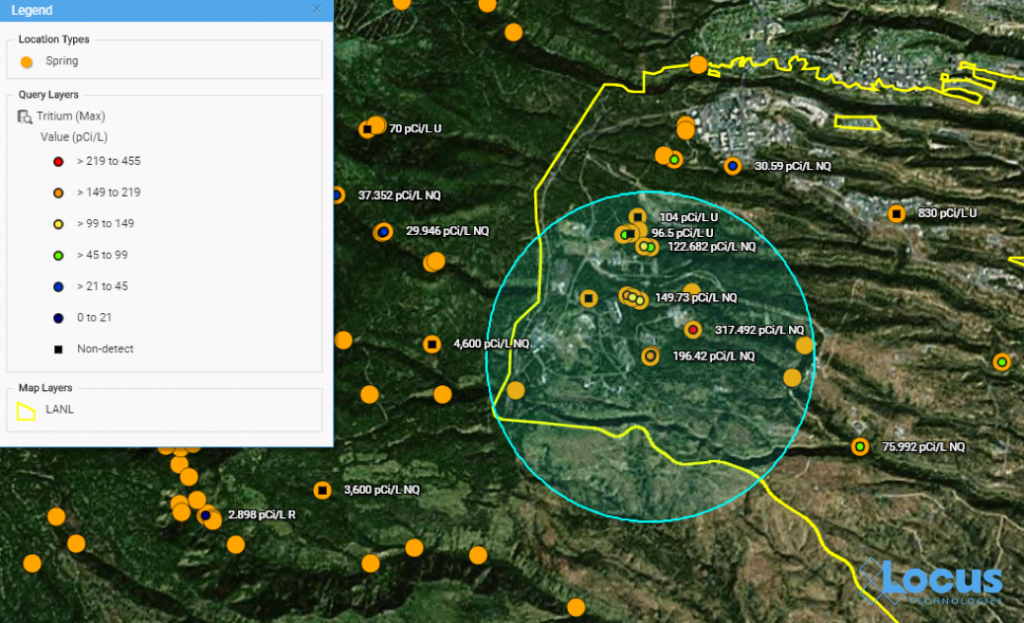
Content services integrations provide up-to-date regulatory notifications
From a private API perspective, consider content management services like RegScan and Specialty Technical Publications (STP). Using services like this, companies can connect with third-party content providers to get information about the latest important environmental regulations delivered within their software application. This is a great concept as no software vendor can excel at all dynamic regulatory programs, so it makes sense to purchase the information from providers who specifically focus on certain types of content. Another example is product regulatory compliance or online Material Safety Data Sheets (MSDS).
Any modern online specialty knowledge vendor will be able to supply an API for accessing and integrating their service information into an existing modern EHS software solution. This means EHS software users can access articles that provide clear analysis on evolving environmental regulations or other topics of targeted interest with the content managed by the content provider. Additional features may also be available from the content vendor such as alerts or notifications so content consumers can stay up to date with changes. Through robust integration via public or private API, software vendors can provide enhanced content to users well beyond what the software vendor natively supplies.
Two major advantages of public and private APIs is that no permissions are needed to access the information, and that users have immediate access to current and reliable content at all times. Effective integrations can reduce the time needed to research related information from other sources and eliminate many manual errors by having applications connect directly to each other.
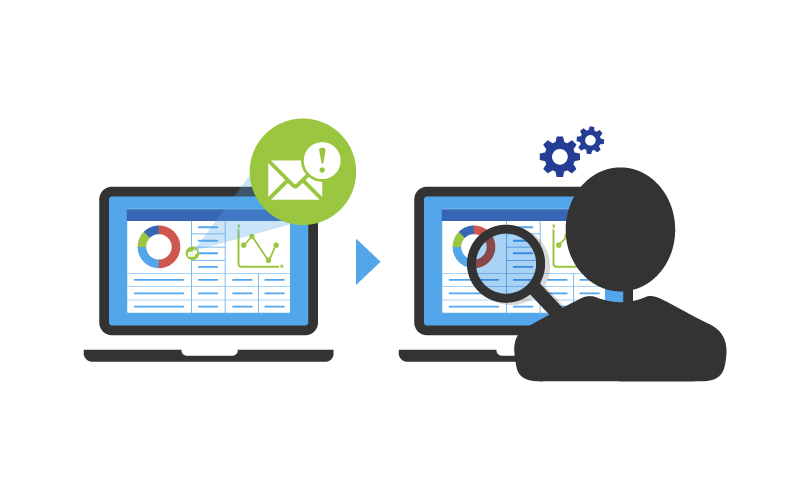
Another common integration request is “portal integration”, or the melding of various streaming data sources (such as “big data” or IoT data) into a single system to enable better data analysis and insight. For example, many companies have multiple continuous monitoring systems (CEMS) that generate huge amounts of data at frequent intervals. With such huge volumes of data, it is hard to review and take action without condensing the information into an understandable format.
A modern SaaS platform with built-in integration tools is essential to bring various data sources together and display the information in a meaningful way. Look for dashboards designed to handle this type of data that provide a way to integrate data from different data sources into a single unified view that is easier to interpret. Look for tools that make it easy to combine and present data using different types of graphical charts and as GIS maps.
Like integrations with on-premises systems, system owners will need to be involved in setting up the integration, and software collecting the streaming data will need to be sophisticated enough to be readable by modern systems. If you’re using legacy data collection systems such as SCADA in your organization, you can integrate with those systems as well, avoiding the need for costly hardware upgrades. However, its best to check with the system owners to ensure their systems are able to integrate before you start your EHS system planning.
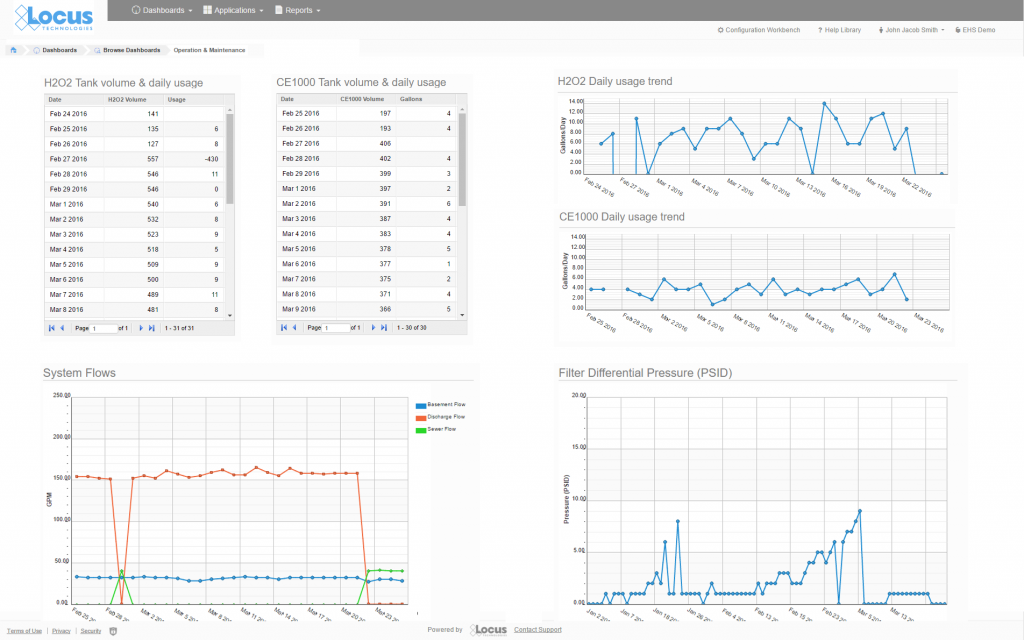
With all the advances in software platforms and commercial data sources providing enhanced linkage to data that was previously unavailable or behind firewalls, EHS software customers have a lot to consider when evaluating options. In the last several years, software integration has become a hot topic and something most EHS departments are at least talking about. If you’re evaluating EHS software solutions, you would be wise to add one or more of these integration capabilities to your “wish list” for any potential vendor solution.
Consider the exact information you want to bring into your EHS software, the quality of the information you want to consume, and the reliability of the source.
Also, remember that internal and external data providers may upgrade or change over time. For that reason, the ease and reliability of integration is an important parameter to consider.
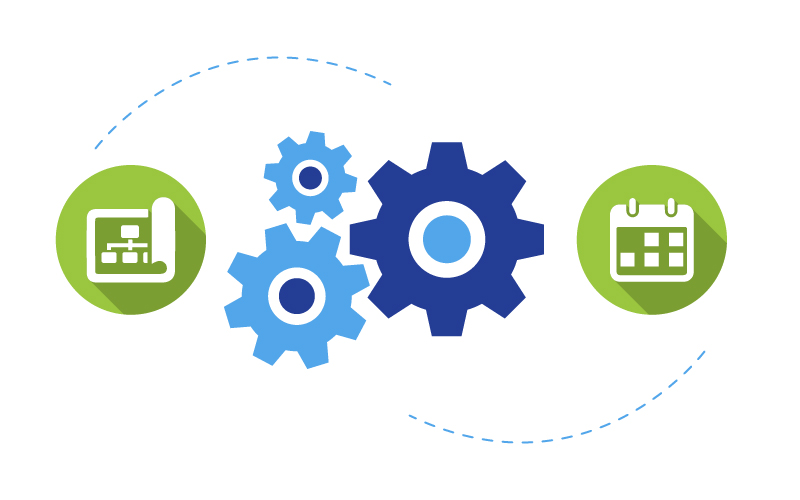
There are many clear benefits to taking advantage of modern integrated software tools wherever you can in your EHS processes. Even if some integrations are only optional for your needs, consider the benefit to your organization in simplifying your EHS software implementation, maximizing other available resources, and improving the reliability and accuracy of data sources driving your EHS decisions.
Integrations are sometimes initially perceived as an optional feature, but you should consider making it a requirement for your EHS software based on these benefits. Moreover, as new integration tools increasingly become available, you’ll find more value out of having a system that can use them to their full advantage.
NAEM recently published this blog as a part of their Green Tie series. Read it here.
Interested in learning more about integration? We recently published a detailed white paper on integrated systems for EHS software. It is available as a free download.
[sc_button link=”https://www.locustec.com/white-paper/extend-ehs-software-integrated-systems/” text=”Download free white paper” link_target=”_self” background_color=”52a6ea” centered=”1″]
Last week Locus attended the first training session offered by California Air Resources Board (CARB) for verifiers under the California Low Carbon Fuel Standard (LCFS) program. The California LCFS program has been ramping up over the past several years, and is now ready to start certifying third-party verifiers to review both applications and routine reporting.
The LCFS program is part of California’s initiative to meet the AB32 requirements of reducing overall greenhouse gas emissions to 1990 levels by 2020, and 40% lower than that level by 2030. LCFS is specifically intended to address emissions from transportation fuels in California, which are approximately half of the overall emissions statewide. Like the Greenhouse Gas Mandatory Reporting Rule and Cap-and-Trade programs that preceded it, the California LCFS program uses a market-based approach to incentivize innovation and new approaches to reduce emissions.
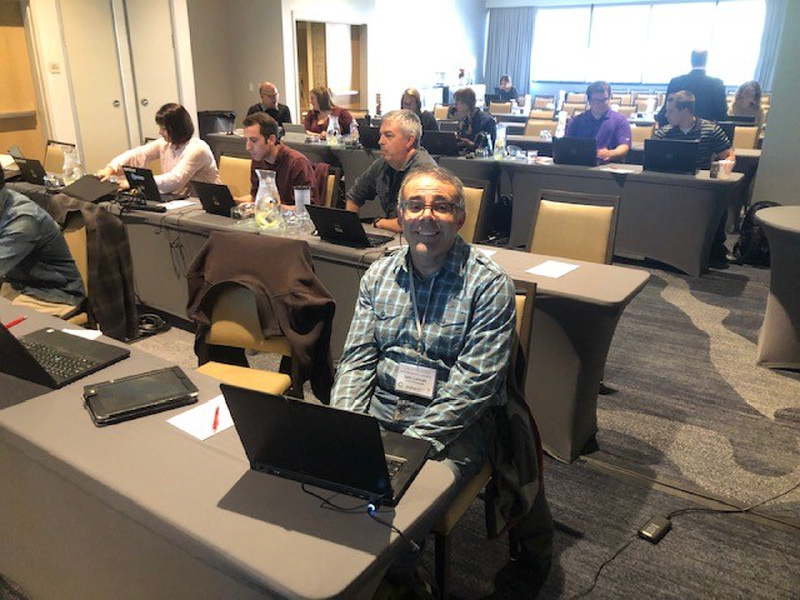
Seth Lalonde, Locus Environmental Scientist, at the California Air Resources Board Training
The program covers a wide variety of projects, including production of alternative fuels (e.g. renewable diesel and biogenic compressed natural gas), innovative approaches to fossil fuel production and refining, and direct carbon capture and sequestration. Fuels are assigned a carbon intensity based on overall carbon dioxide emissions over the entire life cycle, from production to processing to shipping to consumption. The carbon intensity is essentially a measure of the emissions from the fuel per unit of energy. The lower the carbon intensity value, the less impact the fuel has in terms of carbon emissions. Certain fuels can even have a negative carbon intensity, which essentially means the fuel production process is absorbing more carbon than is eventually emitted to the atmosphere (such is the case for compressed or liquefied natural gas produced using biomethane from manure collection). The program also has impacts well outside the California border. After all, fuel that is eventually used in California can originate anywhere in the world, and the LCFS program allows for these projects to obtain credits regardless of their location.
Unsurprisingly, California was the first state to adopt and implement a LCFS program, and the first to establish a third-party verification program specific for LCFS. Although it was clearly the first presentation of this training material, staff from CARB as well as the Climate Action Reserve and The Climate Registry were on hand to assist in addressing questions and topics that weren’t covered in the prepared materials. And considering the wide variety of LCFS project types and the disparate backgrounds of attendees for the verification training, they did a great job of getting everyone all the information they needed to understand and verify these projects.
First and foremost, like any market-based emission program that includes a verification or auditing requirement, transparency is critical. The verifiers are trained to dig deep into your data, and not to take ‘no’ for an answer. Be prepared to have your metadata and documentation assembled and easily made available to the verifier. (For more on Transparency in Reporting, view this webinar)
Second, the LCFS program includes requirements for continuous or near-continuous monitoring for many parameters, and instrumentation capable of electronic data archival. Manual data records and transcription are still acceptable under other carbon offset programs, but under LCFS these options are no longer allowed. Be sure that your instrumentation is consistent with the specific LCFS requirements, or you’ll be seeing a non-conformance from your verifier.
There were many other tips and common pitfalls highlighted during the training for specific LCFS project types. Overall, I’m very excited to see how the LCFS program evolves in California, and how the energy industry takes advantage of these incentives to provide new options for transportation fuels that will reduce carbon emissions.
Update: Locus is now an approved verification body for the Low Carbon Fuel Standard. Learn more here.
[sc_button link=”/services/lcfs-verification/” text=”See our LCFS verification services” link_target=”_self” centered=”1″]
Locus Technologies is proud to have attended this year’s NAEM EHS&S Forum in Toronto. We were represented by Wes Hawthorne, President of Locus, and forum first-timer, Aaron Edwards, Marketing Associate at Locus.
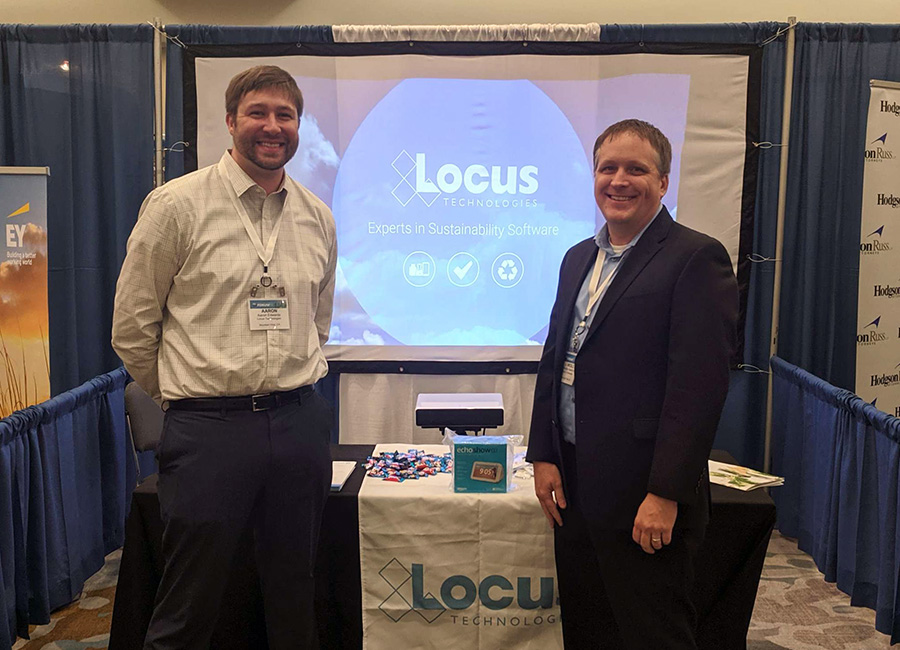
The forum gave us the opportunity to learn, both from our peers in discussions about EHS&S goals, and from the diverse lineup of respected speakers and presenters. You spoke and we listened. This year, the prevailing topic of discussion was the growth of expectation surrounding sustainability in organizations.
Sustainability initiatives are rapidly moving to the forefront of institutional policy at leading organizations. As consumers, investors, and shareholders are increasingly supporting more sustainable organizations, executives are expecting more impactful sustainability initiatives from their EHS&S departments. Not only that, but executives inherently expect sustainability initiatives to positively affect the bottom line. This means that today’s EHS&S professionals have to manage sustainability initiatives that are vital to company success as well as regulatory management and reporting, often with limited resources.
Our conversations at the NAEM Forum often revolved around the time-consuming nature of regulatory compliance interfering with the escalated focus on sustainability. Many of the professionals we spoke with are dealing with multiple EHS&S platforms, each used for a specific function. Time management is increasingly more essential to EHS&S managers, and juggling between uni-tasked platforms is detrimental to effective sustainability efforts.
Locus developers have designed our software to reduce the labor-intensiveness of regulatory compliance. We offer a configurable single-platform solution for decreasing the amount of time you spend managing KPIs. From available modules in waste management, audit tracking, GHG reporting, and more—our configurable software allows more time to improve your company’s sustainability initiatives.
Sustainability is no longer an afterthought in the eyes of executives, consumers, investors, or shareholders. Having one robust software platform can greatly help EHS professionals integrate that “&S” seamlessly with their other responsibilities.
[sc_button link=”/company/contact/” text=”Continue the conversation” link_target=”_self” color=”ffffff” background_color=”52a6ea” centered=”1″]
We all know the struggle of getting things done with shortened staff without compromising the quality of our work, especially in EHS. Locus Technologies’ Locus Platform (LP) offers multiple options to ease your complexity by providing a truly SaaS platform packed with some nifty apps. Here are some tools in LP that can help you utilize your workforce much more efficiently:
Every software has built-in report and dashboards, but they may not meet all your needs when purchased off the shelf. If you need a new report, chart, or other visualization of your data, it usually incurs a custom software development charge, but not with Locus Platform (LP). LP allows you to assemble the information you want in your chosen format (bar or line charts, maps, tables, treemaps, diagrams, etc.) and share your custom dashboards and real-time information/data with your team. In addition, the views and dashboards export to Excel, so you can easily integrate with commonly used tools and further mine the data. At the enterprise level, powerful dashboards will help you understand the status of each facility based on a matrix you design. With the LPs flexibility, facility information can be automatically populated based on the user credentials, saving your team time and frustration.
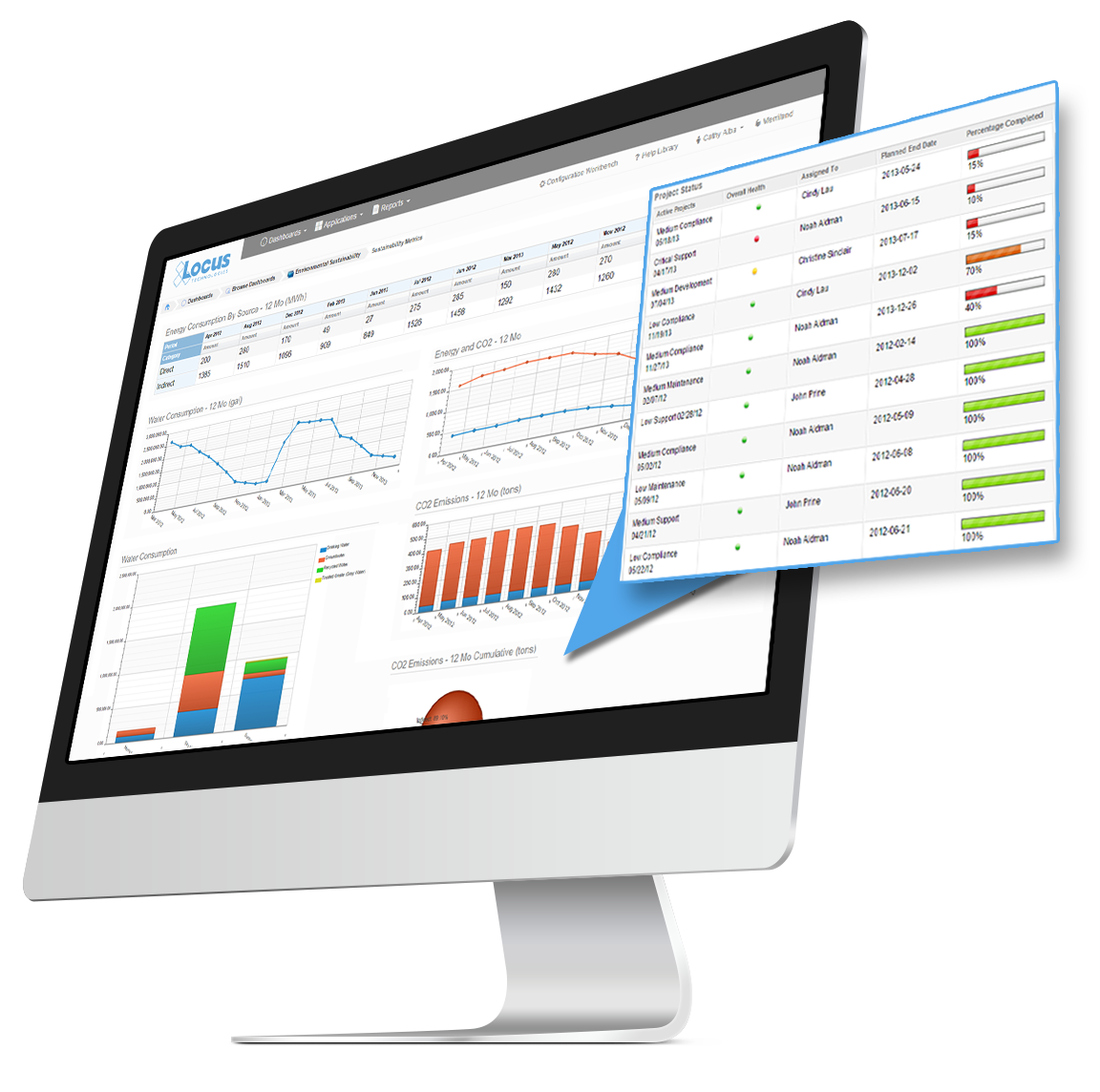
Locus Platform’s Sustainability application and calculation engine support simultaneous calculations using multiple methods for various reporting programs including EPA, California ARB, CDP, TCR, DJSI, and others. This allows users to input data only once and utilize it to report to multiple federal, state, and voluntary reporting programs, according to their required format. The application will also support direct electronic reporting formats for many reporting programs, so that additional manual transcription and submittal of data are no longer necessary. This is a very powerful tool and a huge advantage to customers in terms of improving efficiency, while reducing costs.
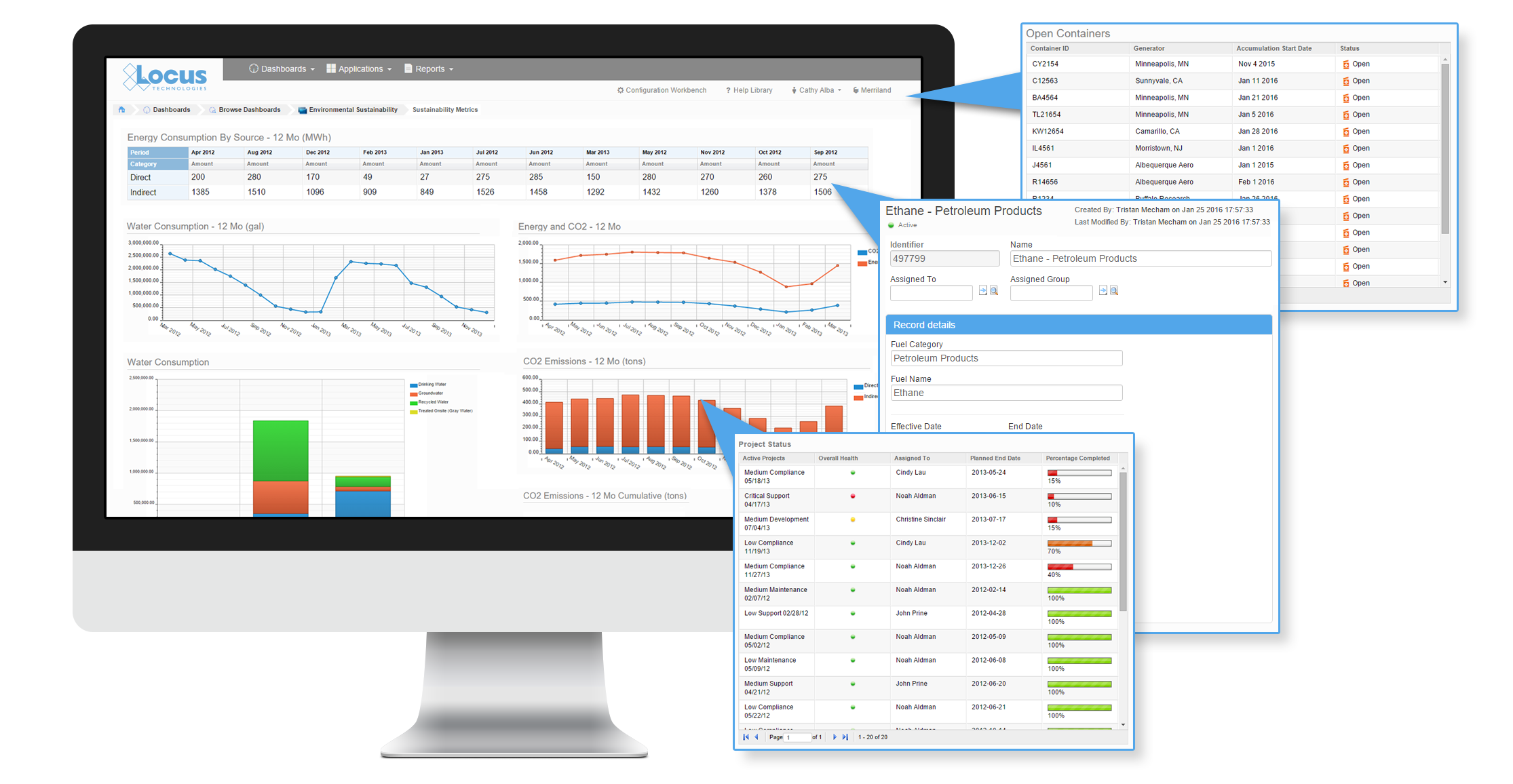
Integration, if done correctly, can save you a great deal of time and headache during some of the most tedious and cumbersome tasks in EHS data management. Locus Platform (LP) has built in a unique point and click integration application to enable connection with major databases or third-party systems that have open API (Access privileges). Some integration, database, and communication standards and methods that are supported include OLE compliance, SOAP, COM, Java, XML, web services, ODBC/ODMA/SQL/Oracle, VIM, and MAPI. LP also works well with MS Excel and provides a powerful two-way synchronization allowing users to download parts of the database to Excel, then work, edit, and verify or append data on their local copy of Excel where they have no internet connection. Any revisions they perform to the downloaded data in Excel can be automatically synchronized back to the Locus Platform application. During the process, a complete audit trail will be preserved. This can be a great time saver especially when you are sending large volumes of valid values in a database or if you are migrating any historical data.
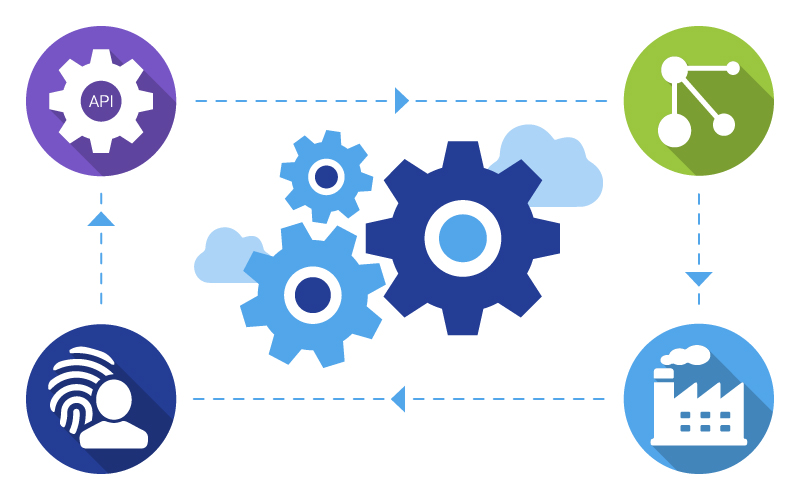
Locus’ Mobile application allows you to sync with your server to create data collection profiles on a mobile device, whether it’s your phone or a tablet. It will allow you to click through and enter data on the device even when you are offline. Data validation is performed in real time and is stored locally on the device, once the phone reaches an internet signal, it will sync with your server, and the data will automatically be updated in Locus’ cloud-hosted solution. What’s more, Locus Mobile works seamlessly with both EIM and Locus Platform.
Using Mobile you receive the benefits of data entry directly on the mobile device, with immediate data availability on the cloud when you reach an internet signal. Other advantages of using Mobile include location metadata and mapping integration, bar-code/OR code scanning, voice recognition, and form customization. If you’d like to know more about the Locus Mobile application, check out the Top 10 cool features in Locus Mobile.
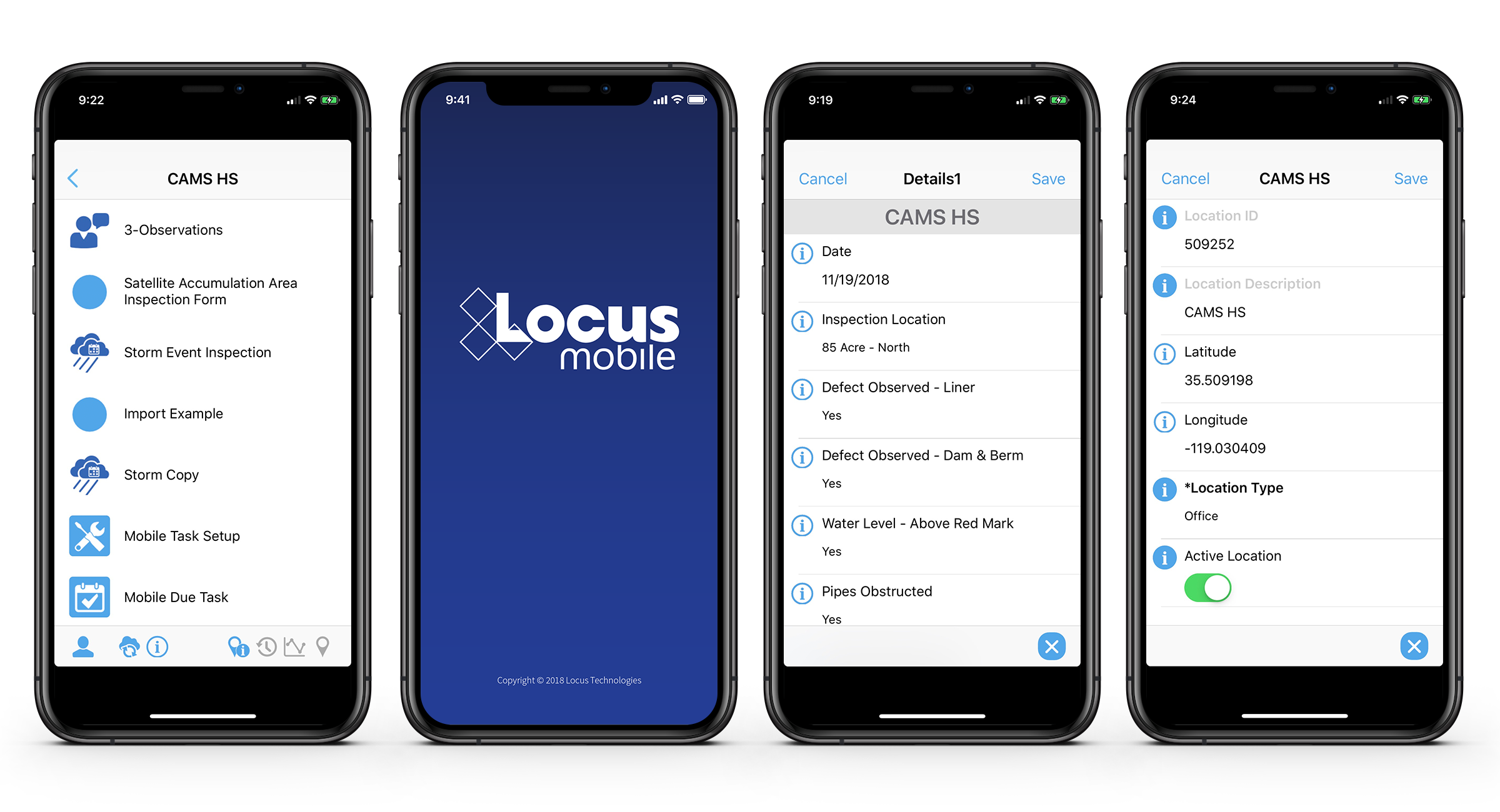
Locus has prioritized enhancing its GHG application in Locus Platform to make it easy to manage GHG emission inventory tracking and reporting requirements. Locus Technologies is the only software vendor that is a certified GHG verifier under the State of California’s AB32, and has performed the most GHG verifications in California since 2015. The State and Federal eGGRT web portals are notoriously cumbersome and require a significant amount of your time to input all the required data and generate your report. But with XML support, you can bypass almost the entire data entry process, and complete your submittal within a few minutes. XML reports support many greenhouse gas subparts, including EPA GHG Subparts C, D, W, and NN. And because data entry for EPA and CARB is consolidated in the XML GHG application, it eliminates the need to maintain separate agency spreadsheets and software. Additional reporting programs are also adding support for XML submittals, such as EPA’s eManifest. This functionality can be a huge time saver for anyone working with these online regulatory reporting tools.
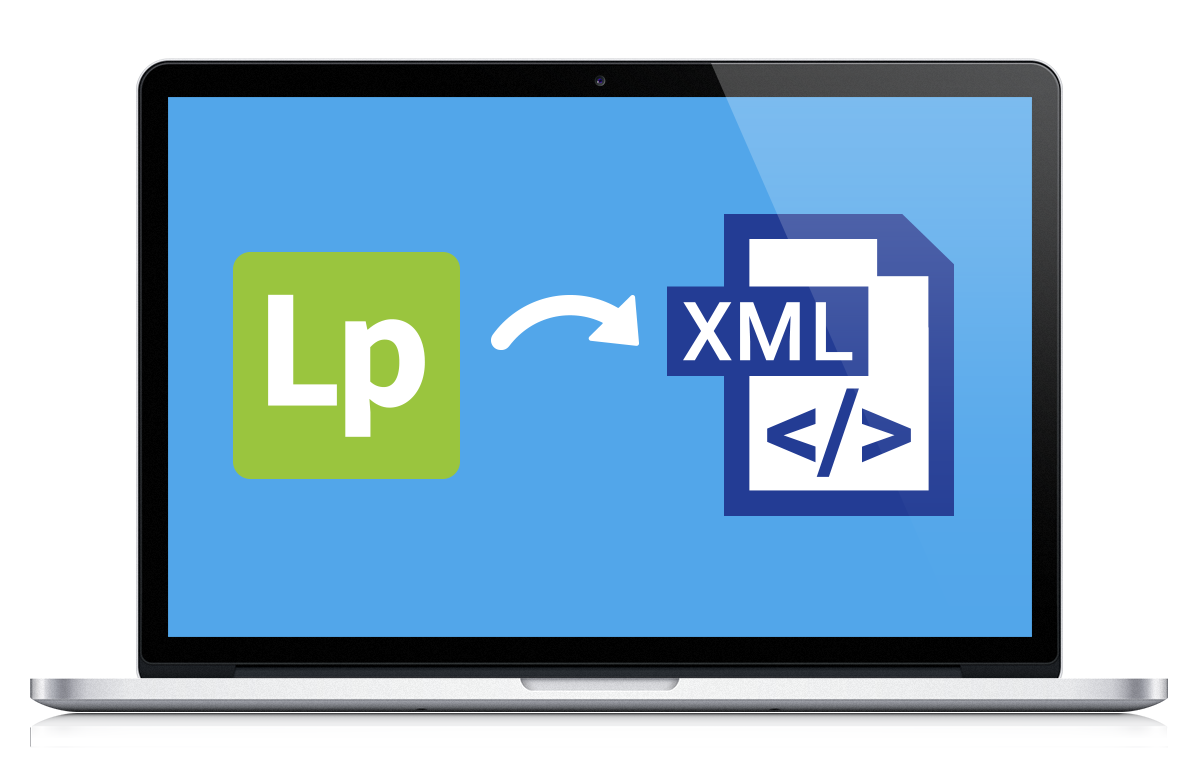
There are roughly 1.6 billion new air conditioning units expected to come on stream by 2050, reflecting increased demand from Asia, Latin America, and Africa.
On 15 October 2016 in Kigali, Rwanda nearly 200 nations have agreed a legally binding agreement to cut back on greenhouse gasses used in refrigerators and air conditioners, a significant move against climate change.
The International deal would require countries to phase out greenhouse gasses called hydrofluorocarbons beginning in 2019.
Under the agreement, developed nations, including much of Europe, the United States, China, and India commit to reducing their use of the gasses incrementally, starting with a 10 percent cut by 2019 with the goal of an 80% reduction globally by 2047. But many wealthier nations and companies have already begun to reduce their use of HFCs.
A parallel deal was struck last year in Paris to slow the growth of carbon emissions, the most prevalent greenhouse gas emitted by the burning of fossil fuels. That deal entered into force earlier this month. But unlike the Paris agreement, the Kigali deal is legally binding, has very specific timetables and has an agreement by developed economies to help emerging countries adapt their technology.
The HFC agreement comes in the form of an amendment to the Montreal Protocol, an international treaty undertaken nearly 30 years ago to protect the Earth’s ozone layer.
According to the Wall Steet Journal article, Chemours Co., a publicly traded chemicals company spun off from DuPont Co. last year (and Locus Technologies customer), said that it was introducing a new line of gasses to help replace HFCs for some industrial-scale refrigeration and air-cooling systems.
The deal is the latest installment in the US administration’s efforts to curb the global greenhouse-gas emissions that scientists say are warming the planet with harmful consequences. Earlier this month, countries also agreed to limit carbon emissions from global aviation for the first time ( http://locustec.com/blog/epa-plans-regulate-carbon-emissions-aircraft/ ).
HFCs account for about 1% of global greenhouse-gas emissions and 1.5% of all U.S. greenhouse-gas emissions, according to the U.S. Energy Information Administration. But they are considered one of the fastest-growing greenhouses gasses in the world. The agency predicts HFC emissions could increase up to 15% a year globally if they aren’t limited.
As a greenhouse gas, HFCs are more potent than carbon dioxide. Their heat-trapping capacity can be hundreds or thousands of times that of carbon dioxide, according to the U.S. Environmental Protection Agency. Plus, some HFCs can stay in the atmosphere for hundreds of years, according to a 2007 report by the Intergovernmental Panel on Climate Change. As a result, even small amounts can have profound, long-lasting effects on the environment.
HFCs belong to a family of compounds known as fluorinated gasses. Such substances don’t exist in nature; they are entirely man-made, according to the EPA. After the Montreal Protocol, HFCs were developed to replace another class of fluorinated compounds, known as chlorofluorocarbons, because these were depleting the ozone layer.
One of the industry challenges will be to track, organize, and report on avalanches of data stemming from the binding HFC compliance requirements. SaaS like Locus Platform is ready for the challenge.
MOUNTAIN VIEW, Calif., Dec. 19, 2023 — Locus Technologies, (Locus)— an industry leader in environmental compliance and ESG software, has been accredited by the Washington Department of Ecology to provide verification services for mandatory greenhouse gas (GHG) reporting. Locus is the first of a select few to receive approval for Washington’s first year requiring verification services.
The accreditation allows Locus to provide verification services for GHG emissions reports, which are now mandatory for facilities in the State of Washington. The verification team at Locus consists of experts in all reporting requirements. Locus’ in-house Lead Verifiers are certified in all reporting types, including general stationary combustion sources, transactions (electricity, fuel, and natural gas suppliers), oil and gas systems, and process emissions.
In May 2021, the Climate Commitment Act (CCA) was signed into law for the state of Washington. The CCA established a state-wide Cap-and-Invest Program to reduce greenhouse gas (GHG) emissions and address climate change. As part of the Program, entities are required to report their emissions and have those emissions verified for accuracy and conformance with the regulation, using accredited third-party verification bodies such as Locus.
“Locus is excited to continue our expansion of GHG services to include verification in the state of Washington, as we have done in California and Oregon since the inception of those programs. We continue our commitment to stay informed on new and updated ESG reporting frameworks, leading with our expert staff and domain expertise. Our years of experience and industry knowledge allow us to provide a vital service, while also leveraging this experience to further expand our ESG software functionality to support these new reporting programs,” said Wes Hawthorne, President of Locus.
Building on over a decade of GHG verification experience, Locus remains the only software provider for collecting, managing, and reporting GHG emissions that is also an accredited verifier.
About Locus Technologies
Locus Technologies, the global environmental, social, governance (ESG), Sustainability, and EHS Compliance software leader, empowers companies of every size and industry to be credible with ESG reporting. From 1997 Locus Technologies pioneered enterprise software-as-a-service (SaaS) for EHS Compliance, water management, and ESG credible reporting. Locus apps and software solutions improve business performance by strengthening risk management and EHS for organizations across industries and government agencies. Organizations ranging from medium-sized businesses to Fortune 500 enterprises, such as Chevron, Sempra, Corteva, DuPont, Chemours, Port of Seattle, The Port Authority of New York and New Jersey, and Los Alamos National Laboratory, have selected Locus.
Locus Technologies’ headquarters is in Mountain View, California.
MOUNTAIN VIEW, Calif., May 2, 2023 — Locus Technologies, the leading EHS Compliance and ESG software provider, today announced that Foster Farms, a top US provider of fresh, frozen, and prepared poultry products and the leading brand of fresh chicken in the Western U.S., selected Locus’s award-winning enterprise Software as a Service (SaaS) to organize and manage their EHS compliance and ESG reporting.
Foster Farm subscribed to an integrated set of apps offered in the Locus Cloud Platform. Some apps include EHS Compliance Management, ESG and Sustainability, GHG Emission Factor and Calculation Management, Inspections, Configuration Workbench, Air Emissions Management, Storm Water, Wastewater, and well data management and reporting.
Locus Cloud is the first fully integrated multitenant platform created from the ground up to allow organizations to manage their environmental, energy, water, waste, carbon, air, health and safety, remediation, water quality, and compliance information in one place. The Locus Platform allows companies to configure their own management, tracking, visualization, and reporting through a graphically driven user interface. This feature enables organizations to configure the software to their needs without worrying about the expensive programming outlays usually associated with customization and single-tenant deployments.
When designing integrated EHS/ESG SaaS, Locus sought to make the complicated workflow and management of environmental data as simple as possible and to make it manageable from a single platform with shared components. The resulting platform offers immense flexibility and endless capabilities with minimal training thanks to the new, intuitive, user-friendly interface design.
“The accurate tracking and reporting of critical environmental resource usage is a necessary part of our compliance responsibilities, and a major component of our efforts to ensure that we are a sustainable producer. The Locus application software will make a significant contribution to our resource management capabilities,” said Don Hill, Foster Farms Director of Environmental Affairs.
“We are delighted that Foster Farms recognized the power of the Locus Cloud platform. Businesses do not want to shop for point solutions from different vendors only to be left with the nightmare of integration, security, synchronization, and vendor management. They want one-stop shops and to avoid having to deal with vendors that don’t integrate well with one another or have spotty service and limited support. Locus will provide Foster Farms single platform through which they can accomplish all their environmental and compliance management needs on a single, fully customer-configurable platform,” said Neno Duplan, President, and CEO of Locus. “Keeping the end user’s perspective in mind, we’ve packed the same 26-plus years of domain expertise that Locus has been offering all along into a highly configurable and scalable software platform built from the ground up on the latest web technologies,” remarked Duplan.
ABOUT FOSTER FARMS
Foster Farms is dedicated to providing families across America with great food. From ready to cook chicken and turkey, to chicken nuggets and corndogs, Foster Farms portfolio of fresh, frozen, and prepared foods, are always welcome whether it’s dinner time or snack time. Since its founding in 1939 Foster Farms has gone on to become one of the largest quality poultry producers in the United States. Headquartered in Livingston, Ca with facilities in California, Oregon, Washington, Colorado, Arkansas, Alabama and Louisiana, the company has nearly 12,000 Team Members, and is committed to building a “culture that nobody wants to walk aways from.”
MOUNTAIN VIEW, Calif., 2 March 2023 — Locus Technologies, the leading EHS Compliance and ESG software provider, received their 17th consecutive award from Environmental Business Journal (EBJ) for growth and innovation in the field of Information Technology in the environmental software with particular focus on EHS, compliance, sustainability, and ESG.
Locus continues to expand its ESG SaaS solution, including built-in business intelligence tools for interactive, actionable insights into unified EHS compliance and ESG data, forecasting tools predicting future ESG reporting, APIs for utility data sources, and interfaces with third-party systems that house ESG data. Locus’s ESG solutions focus on “enter once, report to many.” enabling companies the efficiency of reporting to multiple organizations and numerous standards from a single dataset. Essential built-in reporting includes state or federal regulations and ESG based on standards, including CDP, GRI, SASB, TCFD, and many others.
“Locus’s pioneering work in integrated ESG reporting and EHS compliance software is paying off. As one of the early SaaS leaders in net-zero digital solutions for ESG reporting, Locus continues to provide value to companies that want to be credible with their carbon reporting and sustainability software.” said Grant Ferrier, president of Environmental Business International Inc. (EBI), publisher of Environmental Business Journal.
“With energy transition, climate resilience, and new federal programs driving business, as well as traditional environmental market drivers in infrastructure, air quality, remediation, water and wastewater it is understandable that companies that offer integrates SaaS platform like Locus has advantage.” added Ferrier.
“As Locus continues to expand our EHS and ESG software we would like to thank EBJ for recognizing Locus again for a 17th consecutive year and for noting the new functionality and growing customer base we achieved in 2022. Locus will continue this trajectory into 2023 with new tools designed to simplify EHS and ESG management in our award-winning Locus software, which offers a single system of record and truth for our customers. Locus SaaS platform enables our customers to manage their carbon transactions and inventory with the same rigor, confidence, and transparency as their financial ones.” said Neno Duplan, the Founder and CEO of Locus Technologies.
MOUNTAIN VIEW, Calif., 24 February 2022 — Locus Technologies, the leading EHS Compliance and ESG software provider, was awarded a 16th consecutive award from Environmental Business Journal (EBJ) for growth and innovation in the field of Information Technology in the environmental software with particular focus on ESG.
EBJ is a business research publication providing strategic business intelligence to the environmental industry. Locus received the 2021 EBJ Award for Information Technology by growing and innovating its unified EHS compliance and ESG software platform.
In 2021 Locus took a leading market position in the fast-growing space of ESG software. Locus’s ESG SaaS covers carbon data aggregation via a powerful visual calculation engine, investor-grade emissions calculations audit capabilities, reporting to multiple standards from a single data set, integration APIs, dashboards, and carbon reduction goal setting and tracking. This separates Locus from competitors as customers demand integrated net-zero ESG software that supports investor-grade data in disclosure rules such as the EU’s corporate sustainability reporting directive, mandatory TCFD reporting, and anticipated SEC action on climate disclosures.
In 2021 Locus continued to expand its ESG SaaS to include built-in business intelligence tools allowing for interactive, actionable insights into EHS and ESG data, forecasting tools to predict future ESG reporting, APIs linking to utility meters, and interfaces with other Locus and third-party systems that house ESG data. Locus’s ESG application is focused on “enter once, report many times.” The gold standard for multinational enterprises with many locations worldwide is to have a system configured to report to multiple organizations and many standards from a single dataset. Essential built-in reporting in the Locus ESG app includes state or federal regulations, internal CSR, and ESG based on whatever standard their organization adheres to, such as CDP, GRI, SASB, TCDF, or more recent World Economic Forum (WEF) attempt to standardize many voluntary standards.
Locus also expanded its ESG consulting expertise by becoming the first and only software provider to offer accreditation services under new Oregon DEQ guidelines requiring third-party verification for GHG and CFP programs.
Besides strong growth in ESG space, Locus also continues to lead the software for water quality management market with the addition of new SaaS customers in 2021, such as the City of Hillsboro, Oregon for water quality management and Westinghouse Electric Company for control of environmental and radionuclides data, cementing Locus’s market leader position in the space of nuclear facilities.
“Locus’s investment in integrated carbon management software and EHS compliance is paying off. As one of the early SaaS leaders in net-zero digital solutions for ESG reporting, Locus continues to provide value to companies that want to be credible with their carbon reporting and sustainability software.,” said Grant Ferrier, president of Environmental Business International Inc. (EBI), publisher of Environmental Business Journal.
“We would like to thank EBJ for recognizing Locus for a 16th consecutive year and for taking note of our industry-leading ESG software. We aim to continue expanding our software offerings to customers in 2022,” said Wes Hawthorne, President of Locus Technologies.
MOUNTAIN VIEW, Calif., 21 December 2021 — Locus Technologies (Locus), industry leader in environmental compliance and ESG software, has been accredited by the Oregon Department of Environmental Quality (DEQ) to provide verification services for mandatory greenhouse gas (GHG) reporting and the Clean Fuels Program (CFP). Locus is the first of a select few to receive approval for verification services.
The accreditation allows Locus to provide verification services for GHG emissions reports, which are now mandatory for facilities in the State of Oregon. The verification team at Locus consists of experts in all reporting requirements. Locus’ in-house Lead Verifiers are certified in all reporting types, including air contamination stationary sources, electricity suppliers, fuel suppliers, natural gas suppliers, natural gas systems, and process emissions. Locus verifiers are also certified for all report types under the Oregon CFP.
The Oregon Environmental Quality Commission (EQC) updated their rules in May 2020 to enhance the data collection of Oregon’s greenhouse gas emissions. The adopted rules incorporate existing reporting and emissions accounting protocols into rule and improve the specificity of how emissions data are calculated, reported, and verified. The regulation requires mandatory reporting and verification of greenhouse gas (GHG) emissions by third-party verifiers like Locus, starting in 2022.
“Locus is proud to become an accredited GHG and CFP verification body for the state of Oregon, as we have been in California since the inception of that program. We are continually committed to staying informed on new and updated ESG reporting frameworks, which we accomplish first and foremost through domain expertise. Our field expertise and industry knowledge allow us to provide a vital service, while also further expanding on our ESG software to support these new reporting programs” said Wes Hawthorne, President of Locus.
Building on over a decade of GHG verification experience, Locus remains the only software provider for collecting, managing, and reporting GHG emissions that is also an accredited verifier. Using this expertise, the software includes unparalleled tools for transparent and auditable calculations for GHG programs.
MOUNTAIN VIEW, Calif., 9 February 2021 — Locus Technologies, the leading provider of EHS Compliance and ESG software, was awarded a 15th consecutive award from Environmental Business Journal (EBJ) for growth and innovation in the field of Information Technology in the environmental industry.
EBJ is a business research publication providing strategic business intelligence to the environmental industry. Locus received the 2020 EBJ Award for Information Technology by growing and innovating their Software as a Service (SaaS) and related services.
Among the key drivers for Locus in 2020 was providing vital solutions to essential organizations during the earliest stages of the COVID-19 pandemic. Locus provided fully digital waste tracking and the tools needed for groundbreaking work in embodied carbon relating to construction projects for the Port Authority of New York and New Jersey, a potentially industry-transforming innovation.
Water utilities used Locus software to deliver over 150 billion gallons of clean water to tap, the equivalent of 235,000 Olympic-size swimming pools, for over five million consumers. Utilities also benefited from newly released Locus tools such as the direct XML export to the EPA, eliminating the need for custom reporting. Locus continued its work as a third-party verifier in Low Carbon Fuel Standard and Greenhouse Gas verifications, providing verification services for over 60 facilities totaling no less than 3.2 million barrels of crude oil, 2.6 million barrels of natural gas liquids, and 88 million bottles of wine.
“Locus continues to lead the environmental industry digital transformation with its forward-thinking product set, pure SaaS architecture and unified set of EHS Applications,” said Grant Ferrier, president of Environmental Business International Inc. (EBI), publisher of Environmental Business Journal.
“We would like to express our joy and gratitude for receiving the EBJ Information Technology award for the 15th year. We look forward to continue providing our customers with pioneering unified EHS and ESG software and services in 2021,” said Wes Hawthorne, President of Locus Technologies.
299 Fairchild Drive
Mountain View, CA 94043
P: +1 (650) 960-1640
F: +1 (415) 360-5889
Locus Technologies provides cloud-based environmental software and mobile solutions for EHS, sustainability management, GHG reporting, water quality management, risk management, and analytical, geologic, and ecologic environmental data management.
